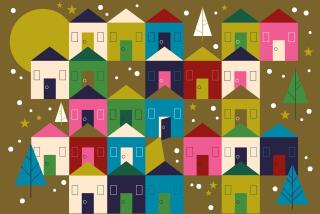Bring Back That ‘Rhapsody in Boo’
- Share via
At last, the hour of bewitchment has arrived--All Hallow’s Eve--when only the bravest of children dare to venture out into the black unknown. “The bogyman will get you if you don’t watch out,” they call to one another with squeals of nervous laughter as they start their rounds of neighborhood visits.
But the bogyman won’t get his chance, because Mother and Father are watching out.
We should never forget how sensitive the young child’s imagination is. All the supernatural elements that give Halloween its potent magic can linger long after the holiday is over, becoming very frightening to children under the age of 7, even if they do not admit it.
All Hallow’s Eve offers children a wonderful opportunity to wake up imaginations and become daring. This should be a children’s holiday devoted to make-believe, mischief, fun, pranks, mystery and magic.
But of the right kind.
In recent years, Mrs. Sharp has noticed that Halloween, long associated with children’s fun and games, is gaining popularity as an adult celebration. Normally friendly bank tellers and grocery-store clerks suddenly appear in gruesome goblin garb, hideous face masks stare down from drugstore shelves. And graphic, macabre images (even on so-called children’s programs) appear on television to “celebrate” the holiday. Believe me, dear parents, with contemporary Halloween observances, the bogyman is the least of our worries.
What is needed, then, is a plan that provides children with a festive holiday that offers a comforting sense of balance and harmony. Which is why Mrs. Sharp’s family celebrates the ancient custom of Harvest Home--a combination of Halloween and All Saints’ Day.
This adapted tradition grew out of Mrs. Sharp’s desire to reassure her children that all the bad ghosties and ghoulies had gone away the morning after the night before. When the children persisted that they could still see “skeletons and devils and all sorts of horrible things hiding behind their eyes,” Mrs. Sharp told them not to worry: She had invited all the good spirits to a Harvest Home dinner that evening in honor of their day--All Saints’. Immediately the children concluded that if there were any leftover evil Halloween creatures lurking about, the Sharp house was certainly not the place to be. At peace, they returned to play and a new tradition was born.
Harvest Home was the traditional Victorian English celebration after gathering in the fields was completed. Over a feast, families would come together to rejoice in their good fortune, pray that others would find their portion, carve festive lanterns out of autumn’s fruits of the earth, and enjoy special foods--such as a ceremonial Harvest Loaf formed in the shape of wheat sheaves.
A Harvest Home festival for the family is similar, in that we rejoice in reaping the rich harvest that love has sown. And there is really no better occasion during the autumn to have a Harvest Home celebration than the day after Halloween--on All Saints’ Day, Nov. 1.
The reason for this is that the giving of equal attention to good deeds as well as ghoulish pranks confirms a young child’s instinctive sense of justness. Furthermore, by having a family party that celebrates our harvest of home blessings, we are able to pass on an emotional security blanket: faith-building rituals that will ward off evil--real or imagined--better than any magic charm.
While All Saints’ Day originated as a religious holiday in the 9th Century, at Mrs. Sharp’s house one does not have to be canonized to qualify for an invitation to dinner. A saint for our purposes is anyone who has lived their life in such a manner as to inspire us. One memorable year, for example, we had St. Francis, Sarah Bernhardt, Abner Doubleday, St. George, Superman, Mark Twain and Snow White as guests.
While over the years, Mrs. Sharp’s Harvest Home festival has developed into quite an elaborate family affair, that first year it simply involved setting an empty place next to each child at the table and during dinner, conversing about what personal heroes and saints we would invite to dinner if we could, and why.
But over time the tradition has evolved into a marvelous opportunity for family fun and memory-making. Each year the children look forward to selecting their “saints” and learning as much about them as possible. The identity of everyone’s guest is also a closely guarded secret and happy hours are spent fashioning their saints’ fancy dress.
Then on All Saints’ Night, before dinner, we have a masquerade parade throughout the house--to the tune of “When the Saints Go Marching In.” Father and Mrs. Sharp then have to guess which “saint” each child is. Granted, the success of this charade usually depends on divine intervention. But the pantomime always ends in great merriment.
At last the family sits down to a festive autumn supper. Mother lights the candles, Father or the oldest child pours the wine and cider, we hold hands and invoke blessings on the meal. Outside, winter’s darkness begins to close in. Inside, we have found our own light.
More to Read
The complete guide to home viewing
Get Screen Gab for everything about the TV shows and streaming movies everyone’s talking about.
You may occasionally receive promotional content from the Los Angeles Times.






